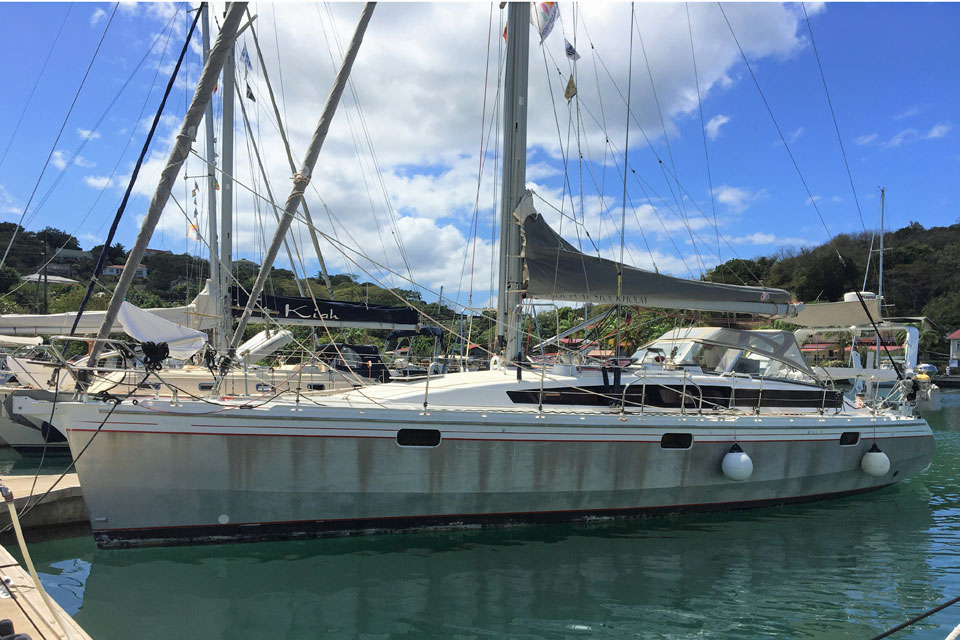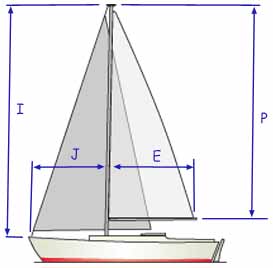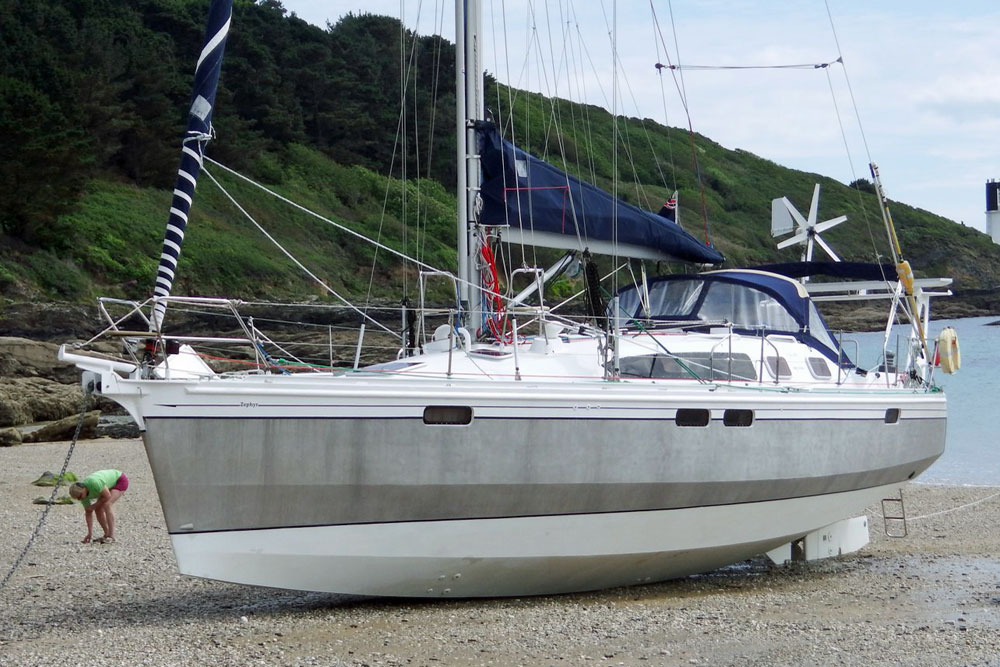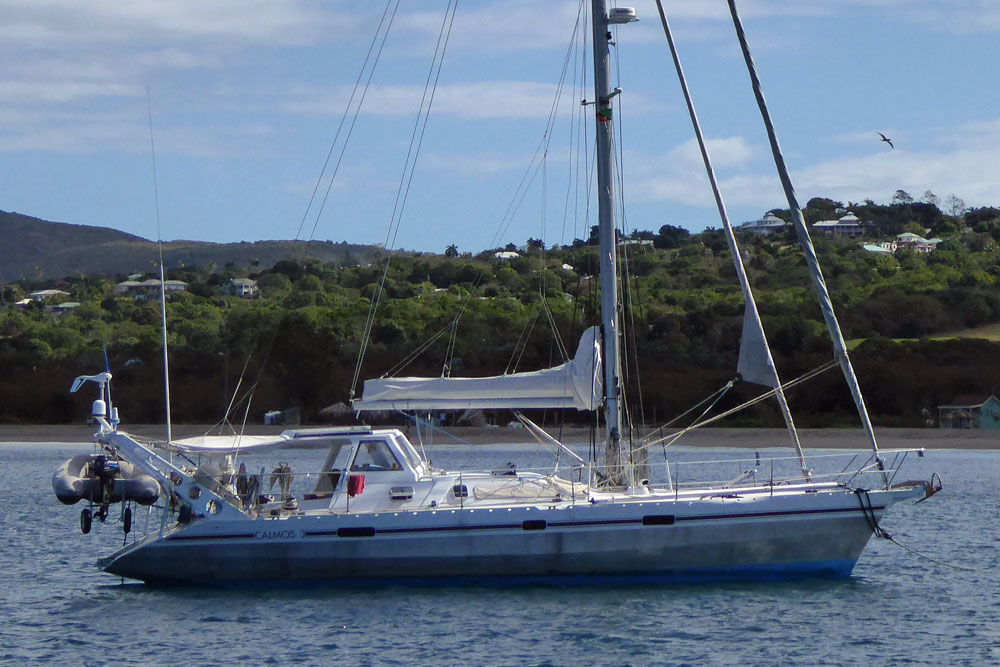- Home
- Cruising Yachts 40' to 45'
- Ovni 445 Sailboat Specs
The Ovni 445 Sailboat
Specs & Key Performance Indicators
The Ovni 445, a light-displacement aluminum cruiser, was designed by the French naval architect Marc Lombard and built by the Alubat shipyard in France.
 The Ovni 445 Sailboat
The Ovni 445 SailboatPublished Specification for the Ovni 445 Sailboat
Keel & Rudder Configuration: Lifting keel with dual rudders
Hull Material: Aluminium
Length Overall: 13.80m (45'3")
Waterline Length: 12.66m (41'6")
Beam: 4.21m (13'10")
Draft: 1.05 to 2.90m (3'5" to 9'6")
Rig Type: Fractional Sloop
Displacement: 11,550 kg (25,463 lbs)
Ballast: 3,725 kg (8,212 lbs)
Water Tank Capacity: 540 litres (143 gallons)
Fuel Tank Capacity: 500 litres (132 gallons)
Hull Speed: 8.64 knots
Designer: Marc Lombard
Builder: Alubat (FRA)
Year First Built: 2008
Year Last Built: Ongoing
Options, Variations & Alternatives
A cutter rig, as in the above pic, was an optional alternative to the standard fractional sloop rig.
Sail Areas & Rig Dimensions
Sail Area (100%): 95.5m² (1,028 ft2)
I (foretriangle height): 17.50m (57'5")
J (foretriangle base): 5.00m (16'4")
P (mainsail luff length): 16.50m (54'2")
E (mainsail foot length): 5.50m (18'1")
Published Design Ratios
The Key Performance Indicators (KPIs)
The following analysis of the design ratios gives an indication of the boat's likely sailing characteristics, but see the 'Notes of Caution' below:
- Sail Area/Displacement Ratio (19.1): This ratio indicates the power-to-weight capability of the sailboat. With a ratio of 19.1, the Ovni 445 falls into the 'reasonably good performance' category. It suggests that the boat is well-powered and should deliver good sailing performance without being overly aggressive.
- Ballast/Displacement Ratio (32.3): A Ballast/Displacement ratio of 32.3 means the Ovni 445 has moderate stiffness and stability. While it isn't as stiff or powerful as a boat with a ratio of 40 or above, it still offers a good level of stability to withstand moderate winds without excessive heeling.
- Displacement/Length Ratio (159): With a Displacement/Length ratio of 159, the Ovni 445 is classified as a Light Displacement boat. This suggests that the sailboat is relatively light for its length, making it easier to reach its hull speed with less sail area. This should contribute to better overall performance and handling, particularly in lighter wind conditions.
- Comfort Ratio (27.3): The Comfort Ratio of 27.3 puts the Ovni 445 in the category of having a somewhat lively motion, typical of a coastal cruiser with moderate stability. While it might not offer the same level of comfort as a dedicated bluewater cruising boat, it should provide a reasonably comfortable ride for most coastal and offshore cruising activities.
- Capsize Screening Formula (1.9): A Capsize Screening Formula result of 1.9 indicates that the Ovni 445 is well-suited for ocean passages and has good bluewater capability. This score, being below 2.0, suggests that the boat has reasonable resistance to capsizing in rough seas, thanks to its balanced beam and displacement.
Summary:
The Ovni 445 is a well-rounded sailboat with good performance and stability. It is capable of providing a lively yet reasonably comfortable experience for coastal cruising and has the structural integrity to handle ocean passages. While it may not be the most powerful or the stiffest boat due to its moderate Ballast/Displacement ratio, its Light Displacement and favourable Comfort and Capsize ratios make it a versatile and dependable choice for bluewater voyages.
Here's how to calculate the KPIs yourself - without having to wrestle with the mathematics...
Design Ratios: Notes of Caution...
- The Sail Area/Displacement Ratio (SA/D): This ratio provides an estimate of the sail power relative to the boat's weight, which can indicate potential speed in various wind conditions. But it doesn't account for the efficiency of the sail plan, the rigging, or the skill of the crew. Real-world performance can vary significantly based on these factors.
- The Ballast/Displacement Ratio (B/D): This ratio gives an idea of the boat's stability and stiffness, which is crucial for handling and safety. But it doesn't consider the distribution of the ballast or the hull shape, both of which can greatly affect stability. A high B/D ratio alone doesn't guarantee a stable boat if the ballast is poorly distributed.
- The Displacement/Length Ratio (D/L): This ratio helps predict the boat's speed potential and its behaviour in different sea conditions. But it doesn't account for the hull design or the boat's overall weight distribution. Two boats with the same D/L ratio can perform very differently if their hull shapes are different.
- The Comfort Ratio (CR): This ratio estimates the boat's motion comfort in a seaway, which is important for long passages. But it doesn't consider the boat's interior layout, which can also affect comfort. Additionally, personal tolerance to motion varies, so a boat that is comfortable for one person might not be for another.
- The Capsize Screening Formula (CSF): This formula assesses the likelihood of a boat capsizing in heavy seas, which is critical for offshore safety. But it doesn't take into account the boat's handling characteristics or the skill of the crew. A boat with a low CSF can still capsize if poorly handled in severe conditions.
General Limitations
- Static Nature: These ratios are static measurements and don't account for dynamic factors like wave action, wind gusts, or crew actions.
- Simplification: They simplify complex interactions into single numbers, which can be misleading. Real-world performance is influenced by a multitude of factors that these ratios can't fully capture.
- Context: The context in which the boat is used (e.g., coastal cruising vs. offshore racing) can greatly affect how these ratios should be interpreted.
In summary, while these ratios provide valuable insights into the theoretical performance characteristics of a sailboat, they should be used as part of a broader assessment that includes practical experience, sea trials, and expert advice.
Other sailboats in the Ovni range include:
This article was written with the assistance of Gemini, a large language model developed by Google. Gemini was used to gather information, summarize research findings, and provide suggestions for the content and structure of the article.
Recent Articles
-
Is Marine SSB Still Used?
Apr 15, 25 02:05 PM
You'll find the answer to this and other marine SSB-related questions right here... -
Is An SSB Marine Radio Installation Worth Having on Your Sailboat?
Apr 14, 25 02:31 PM
SSB marine radio is expensive to buy and install, but remains the bluewater sailors' favourite means of long-range communication, and here's why -
Correct VHF Radio Procedure: Your Questions Answered
Apr 14, 25 08:37 AM
Got a question about correct VHF radio procedure? Odds are you'll find your answer here...















